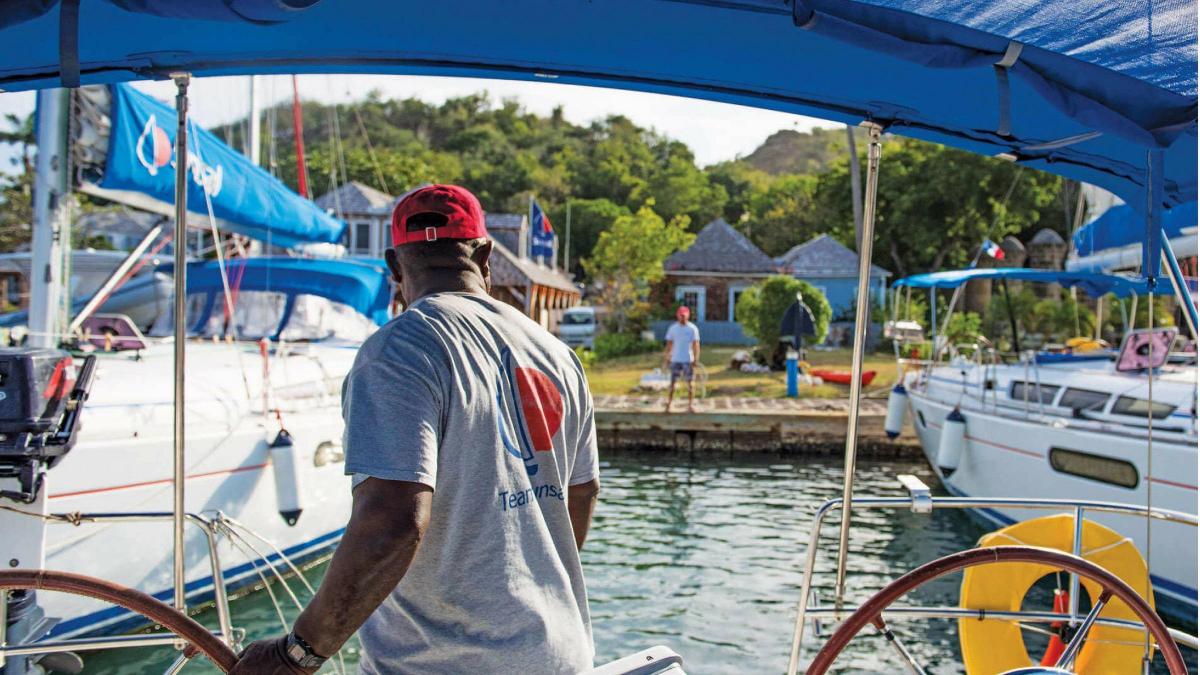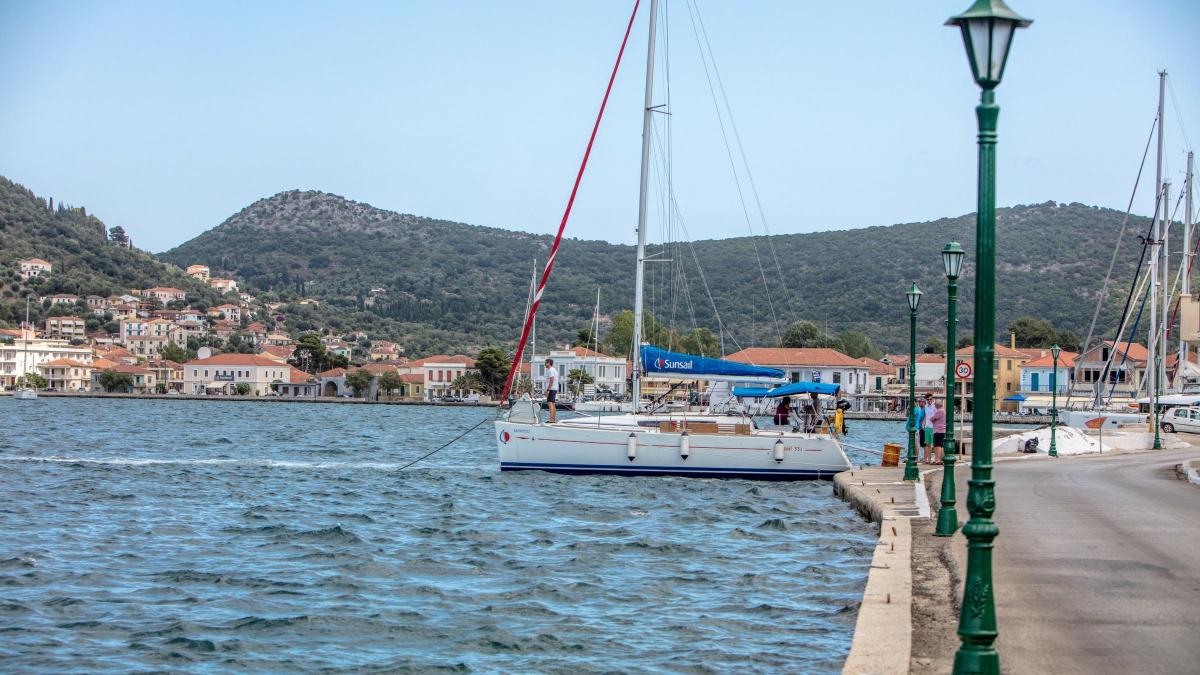
There are many ways to moor in the Med but here are 9 practical tips for stern-to mooring, as well as other possible berthing techniques you need to know.
Ah, the Mediterranean – home of European sailing holidays, with thousands of miles to explore on relaxing summer weeks cruising between places bursting with character. But this unique and beautiful sailing area carries a few challenges, as methods of berthing vary from country to country and port to port. The most famous of these, that we will look to address here, is stern-to mooring
As the season gets into full swing, here are our top tips for staying in control of every maneuver you’ll need to master the Med. These will help get you moored up and in the taverna in next to no time. In short, the key is to have everything ready, put plenty of fenders out, and take it easy.
1. Prop walk
Always factor prop walk into your plans when maneuvering in reverse, such as when you’re mooring stern-to, whether with an anchor or a lazy line. All Sunsail monohulls walk to port, so you can use this to your advantage when reversing into a space.
2. Wind
Assess the wind conditions before attempting the maneuver, and think about how the wind in its current strength and direction will affect your yacht, not just as it sits now, but in a few hours’ time. Is there good enough holding for an overnight stop? Are you far enough off the quay to avoid damage if an evening wind blows?
3. Anchor
Know your anchor – learn its length and understand where you need to start dropping it so that you get the right amount of chain out but also have enough length to reach the quay. There’s nothing worse than performing a perfect stern-to mooring, only to find that you’re stuck 6ft off the quay with no more chain left! If this does happen, see point 6, and go again. If picking up lazy lines, make sure you have someone ready with the boat hook, and ready to walk the line forward swiftly to secure the bow.

4. Mooring lines
It’s important to have two sturdy lines made up at the stern quarters before beginning the maneuver, so you’re ready to secure the back of the boat as soon as possible once you’re in the space.
5. Communication
Keeping everyone aware of what is going on is so important when attempting any maneuver on a yacht, whether under sail or engine. Always make sure to brief your crew well ahead, so that everyone knows their role and what is expected of them. Being ready is half the battle.

6. Maneuvering
a) Forward-Neutral-Reverse-Neutral-Forward
The key things to remember when moving a yacht into and out of a berth using a combination of forward and reverse throttle are to take your time and respect your engine gearbox. It’s far too easy in the middle of a maneuver to throw the throttle back or forward without going via neutral, which will do you no favors at all, especially when the gearbox packs up.
b) When to steer
The classic error made by many skippers when beginning to go astern is to move the wheel while reverse is engaged but they still have forward way on. The fishtailing this inevitably leads to can easily be avoided. Just remember to wait until stationary before turning the wheel, and everything will run smoothly.
7. If at first you don’t succeed
Don’t be afraid to try again. Sometimes even the very best boat handling experts have to give things a second go. Conditions can be challenging and it is always better to get it right than get it done, however many attempts you take to get the yacht lined up correctly.

8. Keep calm
Easy to say, harder to do in the heat of the moment, but remaining calm and communicating clearly are the keys to a successful maneuver. A calm skipper instils belief in his/her crew, and allows them to focus on doing their job right.
9. Setting off
Before setting off in the morning, make sure you keep the windward stern line on until the last minute. This will help keep control of the bow, so you can make steady progress out of the berth.
Other tips
Stern-to is obviously not the only way to moor up in the Med. Here are some quick pointers on the other methods in your arsenal.
Anchoring
The most essential skill and one you’ll need every day for lunch stops, as well as the occasional night in a quiet anchorage.
- Factor in swing room – don’t let yourself get too close to others! You will need to assess your yacht’s likely settled position, and position if the wind changes, to make sure you’re not too close to your neighbors. This is especially important in the more popular lunchtime anchorages like One House Bay in the Ionian. Remember to allow enough swing room for the yacht to do a full circle without overlapping any other yacht’s circles.
- Depth – it will be different at drop and anchor/chain settle points, so check the pilot book and chart to make sure you have enough depth for where you are and where you’ll swing to.

Line ashore
A variation on anchoring, this negates swing, but can only be performed safely if all other yachts also do it.
- Prepare early and talk through the maneuver. Because of the logistics involved, you’ll need to develop a bit of a plan of action, which may vary depending on your environment (are there any large, sturdy rocks nearby? Or would it be more prudent to take the kedge ashore and dig that in?). Focus on getting the anchor to hold first and foremost, then get the line on and tightened
- Assess the terrain and decide if you need to row, motor or swim ashore with the line.
Bows-to
Often an easier option for smaller boats, as yachts behave more ‘normally’ when going forwards, and it keeps you clear of any underwater ballasting. There is also a privacy gain as your cockpit is further from the quay. Not recommended on yachts larger than 40ft.
- Get everything ready in advance – have a clean and clear way of deploying the kedge anchor over the back of the boat, and make sure you have enough rode to get the anchor dug in and reach the quay.
- Have a way of getting ashore! One of the main issues with bows-to is that you’ll need to go over the pulpit to get ashore. So always assess how easy it’ll be to get off before attempting to go bows-to.
So there you have it – Sunsail’s guide to stern-to mooring and maneuvering in the Mediterranean. The most important thing of all is to relax and enjoy it. Now that you know the theory, why not put it into practice in perennial favorite cruising grounds, like the Inland Sea?
Contributor
magali
Step Aboard Here
Start your experience with Sunsail on land and sign up to receive e-mails from us about yachts, offers and destinations.
By clicking 'Sign up' you confirm that you have read and understood our Privacy Policy and consent to our use of your information.



